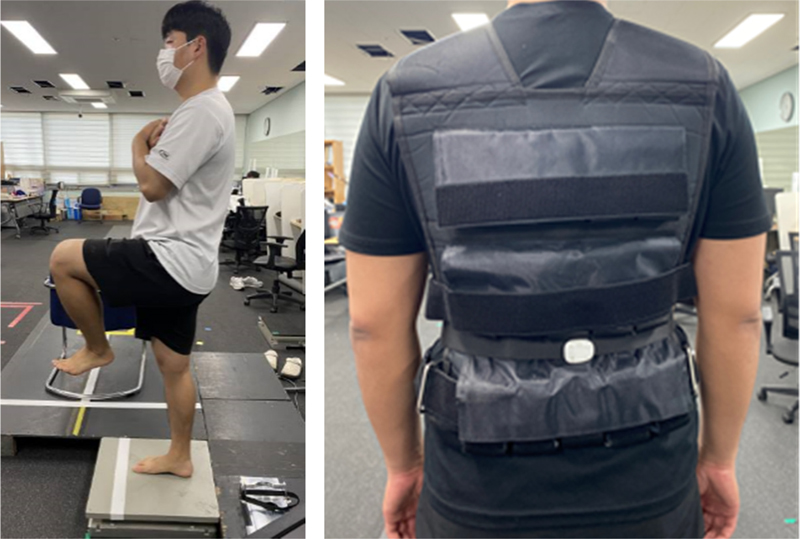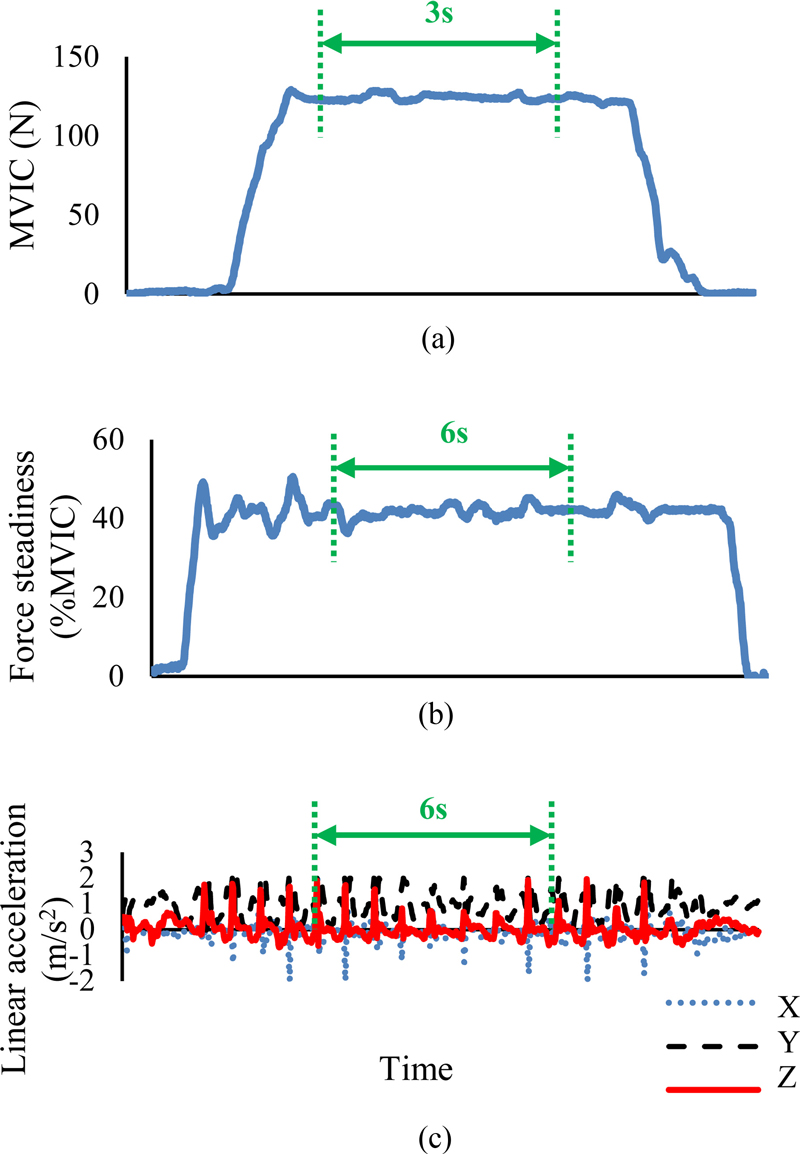
Prediction of Falls Risk Using Toe Strength and Force Steadiness based on Deep Learning: A Preliminary Study
 ; Tejin Yoon1, #
; Tejin Yoon1, #
Copyright © The Korean Society for Precision Engineering
This is an Open-Access article distributed under the terms of the Creative Commons Attribution Non-Commercial License (http://creativecommons.org/licenses/by-nc/3.0) which permits unrestricted non-commercial use, distribution, and reproduction in any medium, provided the original work is properly cited.
Abstract
Falls are common among older people. Age-related changes in toe strength and force steadiness may increase fall risk. This study aimed to evaluate the performance of a fall risk prediction model using toe strength and force steadiness data as input variables. Participants were four healthy adults (25.5±1.7 yrs). To indirectly reproduce physical conditions of older adults, an experiment was conducted by adding conditions for weight and fatigue increase. The maximal strength (MVIC) was measured for 5 s using a custom toe dynamometer. For force steadiness, toe flexion was measured for 10 s according to the target line, which was 40% of the MVIC. A one-leg-standing test was performed for 10 s with eyes-opened using a force plate. Deep learning experiments were performed with seven conditions using long short-term memory (LSTM) algorithms. Results of the deep learning model were randomly mixed and expressed through a confusion matrix. Results showed potential of the model's fall risk prediction with force steadiness data as input variables. However, experiments were conducted on young adults. Additional experiments should be conducted on older adults to evaluate the predictive model.
Keywords:
Active seniors, Toe strength, Force steadiness, Accelerometer, Deep learning, LSTM키워드:
액티브시니어, 발 근력, 힘 안정성, 가속도, 딥러닝, 장단기 메모리1. Introduction
With aging, physical functions such as muscle strength and sense of balance may decrease, and various problems may occur [1,2]. In particular, falls are the most common problem in older adults, and it is reported worldwide that about 28-35% of older adults aged 65 or older experience falls every year [3]. Moreover, post-falls physical dysfunction and complications are social and economic factors that threaten the lives of older adults [4], and falls are one of the severe problems reported as the sixth cause of death for older adults [5,6].
Older adults tend to have an increased fear of falling after experiencing their first falls, and an increase in fear of falling may further increase the incidence of falls in the future [7]. Therefore, there is a need for a method that can prevent and safely manage falls of older adults by classifying risk groups before experiencing falls. Accordingly, various tools for evaluating falls or quantifying the falls risk have been developed and used in clinical settings. However, the tools used to date lack consistency in validity and reliability [8] and have several limitations. For example, the PPA (Physiological Profile Approach) questionnaire, which evaluates the multidimensional risk factors of falls, is highly reliable for assessing falls risk, but requires a lot of time [9]. In addition, although falls history is used as an indicator of falls risk in clinical practice, there is also a limitation in relying on the participant's memory [10]. The Tinetti scale and Berg test are mainly used in clinical practice as a way to assess an individual's falls risk [6,11]. However, this evaluation method must be done by experts, and can be affected by floor-celling effects [12]. In addition, some evaluation methods rely on simple functional measurements and are less sensitive so that they can be applied only to older adults with visually detectable variations in falls-related physical functions [13]. To overcome these limitations, studies have been conducted to prediction of falls by learning the results of collecting and analyzing biological data using wearable IMU (Inertial Measurement Unit) sensors through machine learning and deep learning [14]. The sensitivity of falls prediction studies using data from inertial sensors was 0.43-0.93, the specificity was 0.545-1, and the accuracy was 0.57-0.90 [14]. These studies conducted models by including variables that change with aging, such as stride, gait speed, total gait time, and maximum angular velocity. However, there needed to be a consensus on the variables used in the prediction model [14].
The risk factors of falls are divided into external and intrinsic factors. Intrinsic factors include an increase in age, a decrease in balance ability, a decrease in muscle strength, a falls experience, a decrease in vision, and a decrease in cognitive function [15]. In particular, the decrease in muscle strength and force steadiness caused by aging can lead to significant problems [2,16,17]. Muscle loss and muscle function decline due to aging appear more severe and faster in the lower body muscles responsible for walking than the upper body muscles [2]. In particular, a strong association exists between toe flexion strength and gait and balance ability in older adults [18]. Previous studies have shown that the older adults have about 35% lower toe strength than young adults, and older adults with falls experience have about 20% lower toe strength than older adults without falls experience [19]. Furthermore, it has been reported that force steadiness is associated with functional performance in older women [20], and low force steadiness is found in people with falls experience [21].
Despite the strong association of toe strength and force steadiness with the falls risk [22], studies have yet to be conducted using toe strength and force steadiness in deep learning modeling to predict of falls risk. Therefore, the purpose of this study is to evaluate a falls risk prediction model using toe strength and force steadiness data as input variables.
2. Methods
2.1 Participants
The participants were four healthy adult men (Mean±SD; age: 25.5±1.7 yrs; mass: 77.6±17.3 kg; height: 174.5±7.3 cm; body fat: 23.9±4.7%) who had never experienced falls before. In addition, those with a history that can affect balance ability and those who have undergone neurosurgical surgery on the lower extremities over the past six months were excluded. Before participating, all participants received sufficient explanations and training on the experimental goals and processes.
2.2 Experimental Setup
In order to indirectly reproduce the physical condition of older adults with a high falls risk, two conditions were added to the experiment. Weight increase conditions to reproduce the increase in fat accumulation due to aging and fatigue increase condition to reproduce the decline in muscle strength and nervous system function [16,23,24]. As for the weight increase conditions, the experiment was conducted by adding 10% and 20% of the participants' weight using a weight vest (weighted best heavyweight vest, body X, and China). As for the fatigue increase condition, the fatigue protocol was performed using a toe dynamometer custom-made device. The fatigue protocol maintained toe flexion at 50% of the MVIC (maximal voluntary isometric contraction) for 6 seconds and repeated rest for 4 seconds [25]. If the toe strength during toe flexion did not reach a threshold corresponding to 50% of the MVIC, the fatigue protocol was discontinued based on the assessment of increased fatigue.
2.3 Toe MVIC and Force Steadiness
MVIC and force steadiness were measured using the dominant foot, and the foot used to kick the ball far was selected as the dominant foot. MVIC was measured in a chair posture using a custom-made toe dynamometer. The toe dynamometer and measurement posture are shown in Fig. 1. Participants placed the dominant foot on the toe dynamometer while sitting comfortably in a chair with both feet shoulder-width apart, and the right foot was placed on a scale of similar height to match the height of the right foot. The first and second phalanges were hung on the toe dynamometer ring to adjust the ankle-fixing device’s position, and the ankle was fixed with a strap so that the foot’s position did not change. After getting up from the chair and supporting the weight evenly with both feet, the toe flexion was maintained for 5 seconds with maximum effort according to the inspector’s signal and rested for 1 minute. Force steadiness was measured similarly to MVIC measurement. The toe flexion was maintained for 10 seconds by aligning it as close as possible to the target line corresponding to 40% of the MVIC. The force value of the load cell attached to the toe dynamometer was sampled at 1000 Hz.
2.4 One-leg Standing Test
Static balance ability was used as a variable to prediction of falls risk. One-leg standing test was used to prediction falls among the items performed in the BBT (berg balance test) [26]. Participants prepared for the experiment on a force plate (OR6-7-2000, AMTI, USA) to flexion the hip and knee joints of the non-dominant legs by 90° and stood on the dominant legs with both hands crossed and fixed in front of the chest to maintain balance. The balance was maintained for 10 seconds while staring at the display point of the monitor 3 m ahead with the eyes open [27]. The one-leg standing test posture is presented in Fig. 2. The force and moment data of the force measuring plate in the three-axis direction were sampled at 1000 Hz during the one-leg standing test.
2.5 Timed Up and Go Test (TUG)
Before TUG (timed up to go) test, the belt with the inertial sensor (MetamotionRL, Mbientlab Inc, USA) was fixed to the thinnest part of the waist. The location of the inertial sensor attachment is shown in Fig. 2. Participants stood up from the chair according to the instructions, turned around the cone in front of 6 m, and sat back on the chair. While standing up and walking, the acceleration value of the inertial sensor in the tri-axial direction was sampled at 100 Hz.
2.6 Data Analysis
The MVIC of the toe was normalized by dividing it by weight among the data collected for 5 seconds from the load cell of the toe dynamometer. Force steadiness used intermediate 6-second data from 10-second data. The TCOP (total distance center of pressure) was calculated using the middle 6 seconds data among the 10 seconds data collected by force plate during the one-leg standing test, and the foot length was standardized. The representative data of one participant are presented in Fig. 3. The ACC (acceleration) value obtained with the IMU was a linear acceleration value that eliminated the influence of gravity, and data collected during the TUG test were used from the time of rise to the time of re-sitting in the chair.
2.7 Deep Learning Algorithm
This study used a deep learning technique to prediction of falls risk using MVIC data, Force steadiness and ACC data. Various algorithms exist depending on the purpose of deep learning, and this study used LSTM (long short-term memory) algorithms to prediction of falls risk using signal data. LSTM algorithm, one of the RNN (recurrent neural network) techniques, was used as a deep learning method. LSTM algorithms have a circular structure and are advantageous for continuous and repetitive signal data by passing the values of previous state data to the current state [28].
Based on 16 existing data (4 participants × four conditions), we multiplied by nine values (0.95-1.04) per data to compensate for the insufficient data. The total of 160 data were conducted under seven conditions. Seven deep learning conditions are presented in Table 1.
The TCOP data, which is a falls risk variable used as the label value, was organized in ascending order and labeled as 0 = Low and 1 = High, and 0 and 1 were classified based on the TCOP value 25 by 80 each to equalize the number of labels [29]. The data were divided into learning, verification, and test data at a ratio of 64 : 16 : 20 and trained in a deep learning model. The results of the deep learning model were randomly mixed with data to evaluate reliability, and the average value of the results was expressed through a confusion matrix. Formulas from previous papers were used to calculate sensitivity, specificity, and accuracy [30]. In formulas, TP (true positives) and TN (true negatives) denote the prediction of falls risk classified correctly by the algorithm as positive and negative, respectively. While FP (false positives) and FN (false negatives) denote the prediction of falls risk misclassified positive and negative, respectively.
| (1) |
| (2) |
| (3) |
In addition, additional deep learning experiments were conducted by classifying data labeling into three categories to provide information on the degree of falls risk rather than the dichotomy of classifying the falls risk as ‘there is’ or ‘no.’ 0 = Low, 1 = Moderate, and 2 = High were labeled, and 0, 1, 2 were designated according to the TCOP values of 50, 60, and 50 each to make the number of labels uniform. Additional deep-learning experiments were also conducted under the same conditions as previous experiments.
3. Results
In this study, we used paired t-test to compare the variables by aging condition before deep learning algorithm. Force and balance was significantly decreased in the fatigue condition compared to the baseline (p < 0.01, p < 0.05). And to perform a falls risk prediction using toe strength and force steadiness, we built a deep learning model consisting of LSTM. Then, we trained, validated and tested it using signal data.
The sensitivity, specificity and accuracy of validation algorithms with two-labels is shown in Table 2. And Table 3 shows the performance in terms of sensitivity, specificity and overall accuracy of the algorithm with three-labels.
4. Discussion
This preliminary study used toe strength and force steadiness data as input variables to create a prediction of falls risk model through deep learning and evaluate the model’s performance. As a result of t-test, force and balance significantly decreased in the fatigue condition. But, there is no significant in other conditions. This could be considered that the increase of fatigue indirectly affected the aging condition. While, deep learning algorithm with force steadiness achieved 86% accuracy in two-labeling conditions. This study showed the possibility of prediction of falls risk using force steadiness. However, there are limitations in optimizing the algorithm used in this study. We considered that further research should complement the algorithm using in this study.
The sensitivity, specificity, and accuracy of the model using force steadiness as input variables showed the potential of falls risk prediction than other models. Force steadiness is an important aspect of muscle strength control, because accurate force control ability is essential in performing physical movements [17,31]. Aging can affect force steadiness, and the ability of older adults in force steadiness is impaired [32], and force steadiness is associated with falls in older adults [17,21]. Therefore, the results of this study are considered to reflect the results of previous studies that force steadiness affect falls due to aging. However, it should be noted that the one-leg stand test and force steadiness test used similar contraction mode, and which may have exaggerated the sensitivity of the model. In addition, the results of this study are the results of conducting experiments on young adults, not the older adults. Therefore, the model should be re-verified through experiments on older adults in the future.
Unlike force steadiness, the model with MVIC showed low accuracy in overall experiments with two labels. These results are contrary to the results of previous studies which found that [33] impaired balance ability and falls in older adults are associated with decreased toe flexion muscles [18,19,34]. Toes play an important function during walking and balancing, especially in activities such as walking on unstable or uneven terrain [22]. However, in this study, a one-leg standing test was performed on a flat ground force plate to label the falls risk, it is a static balance ability rather than a dynamic balance ability. Therefore, the results of this study could be interpreted that the MVIC of the lower limb muscles did play a minimal role while maintaining static balance [35], which is partially consistent with previous studies. However, a previous study found that the older adults use more tremendous toe pressure than young adults when maintaining static balance [36]. Considering the previous study results, we assume that further investigation would lead to much better results if actual older people were tested.
To provide more detailed information about falls risk, additional models were created and evaluated by labeling falls risk as ‘low, moderate, and high.’ There was no significant difference compared to the model results made by two labeling. Previous studies that predicted falls risks through modeling for older adults reported that the sensitivity was 0.43-0.93, the specificity was 0.545-1, and the accuracy was 0.57-0.9 [14]. Therefore, it seems likely that the model’s predictive ability shown through this study is comparable to the results of previous papers studied in various ways regardless of the labeling method. Our future work will build on current experiment, but we will experiment with actual older people.
5. Conclusion
This study evaluated a prediction of falls risk model through deep learning using toe strength and force steadiness data as input variables. The deep learning algorithm with force steadiness have a potential for prediction of falls risk prediction. However, this study is an experimental study that reproduces the physical ability of older adults by adding weight and inducing fatigue in healthy young people with a relatively low falls risk. Therefore, further experiments should be conducted on the older adults in the future research to improve the model’s predictive ability.
Acknowledgments
This research was supported by “Regional Innovation Strategy (RIS)” through the National Research Foundation of Korea (NRF) funded by the Ministry of Education (MOE) (2022RIS-005).
REFERENCES
-
Um, S., Jang, S., Park, M., Lee, S., (2022), Impact of wearing functional supporters that prevent seniors from falling on muscle function, Sense of Balance, and Overcoming Fatigue, Fashion & Textile Research Journal, 24(1), 156-163.
[https://doi.org/10.5805/SFTI.2022.24.1.156]

-
Lee, Y.-S., Chang, L.-Y., Chung, W.-H., Lin, T.-C., Shiang, T.-Y., (2015), Does functional fitness decline in accordance with our expectation?–A pilot study in healthy female, BMC Sports Science, Medicine and Rehabilitation, 7(1), 1-6.
[https://doi.org/10.1186/s13102-015-0012-y]

-
Annese, V. F., De Venuto, D., (2015), Gait analysis for fall prediction using EMG triggered movement related potentials, Proceedings of the 2015 10th International Conference on Design & Technology of Integrated Systems in Nanoscale Era (DTIS), 1-6.
[https://doi.org/10.1109/DTIS.2015.7127386]

-
Rubenstein, L. Z., (2006), Falls in older people: Epidemiology, risk factors and strategies for prevention, Age and Ageing, 35(suppl_2), ii37-ii41.
[https://doi.org/10.1093/ageing/afl084]

-
Yamashita, K., Umezawa, J., Nomoto, Y., Ino, S., Ifukube, T., Koyama, H., Kawasumi, M., (2007), The role of toe-gap force for the evaluation of falling risk on the elderly, Proceedings of the World Congress on Medical Physics and Biomedical Engineering 2006: August 27–September 1, 2006 COEX Seoul, Korea “Imaging the Future Medicine”, 405-408.
[https://doi.org/10.1007/978-3-540-36841-0_109]

-
Senden, R., Savelberg, H., Grimm, B., Heyligers, I., Meijer, K., (2012), Accelerometry-based gait analysis, an additional objective approach to screen subjects at risk for falling, Gait & Posture, 36(2), 296-300.
[https://doi.org/10.1016/j.gaitpost.2012.03.015]

-
Pajala, S., Era, P., Koskenvuo, M., Kaprio, J., Törmäkangas, T., Rantanen, T., (2008), Force platform balance measures as predictors of indoor and outdoor falls in community-dwelling women aged 63–76 years, The Journals of Gerontology Series A: Biological Sciences and Medical Sciences, 63(2), 171-178.
[https://doi.org/10.1093/gerona/63.2.171]

-
Tiedemann, A., Shimada, H., Sherrington, C., Murray, S., Lord, S., (2008), The comparative ability of eight functional mobility tests for predicting falls in community-dwelling older people, Age and Ageing, 37(4), 430-435.
[https://doi.org/10.1093/ageing/afn100]

-
Lord, S. R., Menz, H. B., Tiedemann, A., (2003), A physiological profile approach to falls risk assessment and prevention, Physical Therapy, 83(3), 237-252.
[https://doi.org/10.1093/ptj/83.3.237]

-
Ganz, D. A., Higashi, T., Rubenstein, L. Z., (2005), Monitoring falls in cohort studies of community?dwelling older people: Effect of the recall interval, Journal of the American Geriatrics Society, 53(12), 2190-2194.
[https://doi.org/10.1111/j.1532-5415.2005.00509.x]

-
Bogle Thorbahn, L. D., Newton, R. A., (1996), Use of the berg balance test to predict falls in elderly persons, Physical Therapy, 76(6), 576-583.
[https://doi.org/10.1093/ptj/76.6.576]

- Panella, L., Lombardi, R., Buizza, A., Gandolfi, R., Pizzagalli, P., (2002), Towards objective quantification of the Tinetti test, Functional Neurology, 17(1), 25-30.
-
Podsiadlo, D., Richardson, S., (1991), The timed “Up & Go”: A test of basic functional mobility for frail elderly persons, Journal of the American Geriatrics Society, 39(2), 142-148.
[https://doi.org/10.1111/j.1532-5415.1991.tb01616.x]

-
Chen, M., Wang, H., Yu, L., Yeung, E. H. K., Luo, J., Tsui, K.-L., Zhao, Y., (2022), A systematic review of wearable sensor-based technologies for fall risk assessment in older adults, Sensors, 22(18), 6752.
[https://doi.org/10.3390/s22186752]

-
Kim, E.-K., Lee, J. C., Eom, M.-R., (2008), Falls risk factors of inpatients, Journal of Korean Academy of Nursing, 38(5), 676-684.
[https://doi.org/10.4040/jkan.2008.38.5.676]

-
Yeung, S. S., Reijnierse, E. M., Pham, V. K., Trappenburg, M. C., Lim, W. K., Meskers, C. G., Maier, A. B., (2019), Sarcopenia and its association with falls and fractures in older adults: A systematic review and meta?analysis, Journal of Cachexia, Sarcopenia and Muscle, 10(3), 485-500.
[https://doi.org/10.1002/jcsm.12411]

-
Tajitsu, H., Fukumoto, Y., Asai, T., Monjo, H., Kubo, H., Oshima, K., Koyama, S., (2022), Association between knee extensor force steadiness and postural stability against mechanical perturbation in patients with Parkinson’s disease, Journal of Electromyography and Kinesiology, 64, 102660.
[https://doi.org/10.1016/j.jelekin.2022.102660]

-
Menz, H. B., Morris, M. E., Lord, S. R., (2005), Foot and ankle characteristics associated with impaired balance and functional ability in older people, The Journals of Gerontology Series A: Biological Sciences and Medical Sciences, 60(12), 1546-1552.
[https://doi.org/10.1093/gerona/60.12.1546]

-
Endo, M., Ashton-Miller, J. A., Alexander, N. B., (2002), Effects of age and gender on toe flexor muscle strength, The Journals of Gerontology Series A: Biological Sciences and Medical Sciences, 57(6), M392-M397.
[https://doi.org/10.1093/gerona/57.6.M392]

-
Seynnes, O., Hue, O. A., Garrandes, F., Colson, S. S., Bernard, P. L., Legros, P., Singh, M. A. F., (2005), Force steadiness in the lower extremities as an independent predictor of functional performance in older women, Journal of Aging and Physical Activity, 13(4), 395-408.
[https://doi.org/10.1123/japa.13.4.395]

-
Carville, S. F., Perry, M. C., Rutherford, O. M., Smith, I. C. H., Newham, D. J., (2007), Steadiness of quadriceps contractions in young and older adults with and without a history of falling, European Journal of Applied Physiology, 100(5), 527-533.
[https://doi.org/10.1007/s00421-006-0245-2]

-
Mickle, K. J., Munro, B. J., Lord, S. R., Menz, H. B., Steele, J. R., (2009), ISB clinical biomechanics award 2009: Toe weakness and deformity increase the risk of falls in older people, Clinical Biomechanics, 24(10), 787-791.
[https://doi.org/10.1016/j.clinbiomech.2009.08.011]

- Choi, S. J., (2014), Sports Health Medicine: Getting to know fat, about fat between muscles in korean, SPORT it, 128, 66-71. https://kiss.kstudy.com/Detail/Ar?key=3281553
-
Vuillerme, N., Boisgontier, M., (2008), Muscle fatigue degrades force sense at the ankle joint, Gait & Posture, 28(3), 521-524.
[https://doi.org/10.1016/j.gaitpost.2008.03.005]

-
Bigland-Ritchie, B., Furbush, F., Woods, J., (1986), Fatigue of intermittent submaximal voluntary contractions: Central and peripheral factors, Journal of Applied Physiology, 61(2), 421-429.
[https://doi.org/10.1152/jappl.1986.61.2.421]

- Hong, S., Kim, Y.-W., Cho, W., Joa, K.-L., Jung, H.-Y., Kim, K., Lee, S., (2017), Berg balance scale score classification study using inertial sensor, Journal of Rehabilitation Welfare Engineering & Assistive Technology, 11(1), 53-62.
-
Kim, J., Lee, J., Kim, D., Islomjon, B., Lee, K., Yoon, T., (2021), Acute response of toe-spread-out exercise on medial longitudinal arch height and balance, The Asian Journal of Kinesiology, 23(1), 27-33.
[https://doi.org/10.15758/ajk.2021.23.1.27]

-
Yu, Y., Si, X., Hu, C., Zhang, J., (2019), A review of recurrent neural networks: LSTM cells and network architectures, Neural Computation, 31(7), 1235-1270.
[https://doi.org/10.1162/neco_a_01199]

-
Doheny, E. P., McGrath, D., Greene, B. R., Walsh, L., McKeown, D., Cunningham, C., Crosby, L., Kenny, R. A., Caulfield, B., (2012), Displacement of centre of mass during quiet standing assessed using accelerometry in older fallers and non-fallers, Proceedings of the 2012 Annual International Conference of the IEEE Engineering in Medicine and Biology Society, 3300-3303.
[https://doi.org/10.1109/EMBC.2012.6346670]

- Zhu, W., Zeng, N., Wang, N., (2010), Sensitivity, specificity, accuracy, associated confidence interval and roc analysis with practical sas implementations, NESUG proceedings: Health care and life sciences, Baltimore, Maryland, 19, 67.
-
Hirono, T., Ikezoe, T., Taniguchi, M., Yamagata, M., Miyakoshi, K., Umehara, J., Ichihashi, N., (2020), Relationship between ankle plantar flexor force steadiness and postural stability on stable and unstable platforms, European Journal of Applied Physiology, 120(5), 1075-1082.
[https://doi.org/10.1007/s00421-020-04346-0]

-
Tracy, B. L., (2007), Force control is impaired in the ankle plantarflexors of elderly adults, European Journal of Applied Physiology, 101(5), 629-636.
[https://doi.org/10.1007/s00421-007-0538-0]

-
Maki, B. E., Holliday, P. J., Topper, A. K., (1994), A prospective study of postural balance and risk of falling in an ambulatory and independent elderly population, Journal of Gerontology, 49(2), M72-M84.
[https://doi.org/10.1093/geronj/49.2.M72]

-
Lynn, S. K., Padilla, R. A., Tsang, K. K., (2012), Differences in static-and dynamic-balance task performance after 4 weeks of intrinsic-foot-muscle training: the short-foot exercise versus the towel-curl exercise, Journal of Sport Rehabilitation, 21(4), 327-333.
[https://doi.org/10.1123/jsr.21.4.327]

-
Ema, R., Saito, M., Ohki, S., Takayama, H., Yamada, Y., Akagi, R., (2016), Association between rapid force production by the plantar flexors and balance performance in elderly men and women, Age, 38(5), 475-483.
[https://doi.org/10.1007/s11357-016-9949-3]

-
Tanaka, T., Noriyasu, S., Ino, S., Ifukube, T., Nakata, M., (1996), Objective method to determine the contribution of the great toe to standing balance and preliminary observations of age-related effects, IEEE Transactions on Rehabilitation Engineering, 4(2), 84-90.
[https://doi.org/10.1109/86.506405]


Ph.D. student in the Department of Smart Health Science and Technology, Kangwon National University. Her research interest is toe strength and fall risk, development of smart device.
E-mail: yuw9184@gmail.com

M.r. degree graduate in the Department of Smart Health Science and Technology, Kangwon National University. His research interest is fault detection and diagnosis.
E-mail: cotur1215@kangwon.ac.kr

M.r. degree graduate in the Department of Smart Health Science and Technology, Kangwon National University. His research interest is drug delivery and protein engineering.
E-mail: sr7692@kangwon.ac.kr

M.r. degree graduate in the Department of Smart Health Science and Technology, Kangwon National University. His research interest is glucose biosensor.
E-mail: worry234@gmail.com

Post-Doctorate researcher candidate in the Department of Smart Health Science and Technology, Kangwon National University. His research interest is micro/nanoscale surface texturing technologies and the design of medical devices and AI application system design.
E-mail: wkddndrl@kangwon.ac.kr

Professor in the Department of Biotechnology and Bioengineering, Kangwon National University. His research interest is drug delivery and protein engineering.
E-mail: kslim@kangwon.ac.kr

Professor in the Department of Mechanical and Biomedical Engineering, Kangwon National University. His research interest is 3D bioprinting.
E-mail: ahl@kangwon.ac.kr

Professor in the Department of Smart Health Science and Technology, Kangwon National University. His research interest is micro and nano system design and precision control of machine tools he design of medical device and AI application system design.
E-mail: kbh@kangwon.ac.kr

Professor in the Department of Physical Education, Kangwon National University. His research interest is neuromuscular fatigue and development of smart device.
E-mail: tyoon@kangwon.ac.kr



